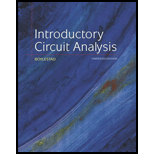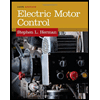
Laboratory Manual for Introductory Circuit Analysis
13th Edition
ISBN: 9780133923780
Author: Robert L. Boylestad, Gabriel Kousourou
Publisher: PEARSON
expand_more
expand_more
format_list_bulleted
Question
Chapter 23, Problem 32P
To determine
The input impedance at the source for the network using PSpice or Multisim techniques.
Expert Solution & Answer
Want to see the full answer?
Check out a sample textbook solution
Students have asked these similar questions
DONT NEED AI THANK YOU.
2 A1
t=0
FIGURE 8.20
2 Ω
w
8 Ω
ic
0.4 H
PRACTICE
8.7 At t = 0.15 s in the circuit of Fig. 8.20, find the value of (a) i;
(b) i₁; (c) i2.
Ans: 0.756 A; 0; 1.244 A.
000
DONT NEED AI THANK YOU.
Chapter 23 Solutions
Laboratory Manual for Introductory Circuit Analysis
Ch. 23 - For the air-core transformer in Fig. 23.57: Find...Ch. 23 - Repeat Problem 1 if k is changed to 1. Repeat...Ch. 23 - RepeatProblem1fork=0.3,NP=300turns,andNS=25turns.Ch. 23 - For the iron-core transformer (k = 1) in Fig....Ch. 23 - RepeatProblem4forNP=240andNS=30.Ch. 23 - Find the applied voltage of an iron-core...Ch. 23 - If the maximum flux passing through the core of...Ch. 23 - For the iron-core transformer in Fig. 23.59: Find...Ch. 23 - Find the input impedance for the iron-core...Ch. 23 - Find the voltage Vg, and the current Ip if the...
Ch. 23 - If VL=240V,ZL=20resistor,Ip=0.05AandNs=50 find the...Ch. 23 - If Np400,Ns=1200andVg=100V,findthemagnitudeofIp...Ch. 23 - For the circuit in Fig. 23.60, find the...Ch. 23 - For the transformer in Fig. 23.61, determine the...Ch. 23 - For the transformer in Fig. 23.61, if the...Ch. 23 - Prob. 16PCh. 23 - Discuss in your own words the frequency...Ch. 23 - Determine the total inductance of the series coils...Ch. 23 - Determine the total inductance of the series coils...Ch. 23 - Determine the total inductance of the series coils...Ch. 23 - Write the mesh equations for the network in Fig....Ch. 23 - Determine the input impedance to the air-core...Ch. 23 - An ideal transformer is rated...Ch. 23 - Determine the primary and secondary voltages and...Ch. 23 - For the center-tapped transformer in Fig. 23.42,...Ch. 23 - For the multiple-load transformer in Fig. 23.43,...Ch. 23 - Prob. 27PCh. 23 - Write the mesh equations for the network of Fig....Ch. 23 - Write the mesh equations for the network of Fig....Ch. 23 - A current transformer has a secondary with 250...Ch. 23 - Generate the schematic for the network in Fig....Ch. 23 - Prob. 32PCh. 23 - Using a transformer from the library find the load...
Knowledge Booster
Learn more about
Need a deep-dive on the concept behind this application? Look no further. Learn more about this topic, electrical-engineering and related others by exploring similar questions and additional content below.Similar questions
- A speech signal has frequencies in the range 50- 3500 Hz. The signal is sampled at Nyquist sampling rate and the resulting pulses are transmitted over PAM and PCM systems. 1- Calculate the minimum bandwidth of the PAM system. 2- Calculate the minimum bandwidth of the PCM system, when the pulses are quantized into 121 levels B) Draw the signaling waveform (line codes) for the binary sequence 10110001 using (Unipolar NRZ, Bipolar RZ, Bipolar NRZ, Manchester code, Differential Manchester (split phase).arrow_forwardDon't use ai to answer I will report you answerarrow_forwardDon't use ai to answer I will report you answerarrow_forward
- 8-1) similar to Lathi & Ding, Prob. P.5.1-2 The figure below shows the Fourier spectra of signals of g,(t) and g₁(t). Determine the Nyquist rate and the corresponding sampling interval for signals of g,(t), g,(t), g₁(1) - g¸(1), g¸³(t), and g₁(1)g₁(1). Hint: Use the frequency convolution and the width property of convolution. G₁(f) G₂(f) -8000 0 8000 f -20000 10 20000 farrow_forward• We will use the Wattmeter to find the average power supplied/absorbed by each component. The following figure shows how to connect the Wattmeter to measure the average power absorbed by the resistor. Note that the Wattmeter consists of a Voltmeter and an Ammeter. The Voltmeter must be connected in parallel with the component and the Ammeter must be connected in series with the component. You must pay attention to the polarity of the voltage across the component as well as the direction of the current flowing through the component. 5Vpk 1kHz 30° ww 40 Z=A-JB Wattmeter-XWM1 2.503 W Power factor: 1.00000 Voltage Current • • Similarly connect a second Wattmeter to measure the average power supplied by the source. Connect a third Wattmeter to measure the average power in the capacitor. Does this value agree with the theoretical value? Perform Interactive Simulation under Analysis and Simulation. Double click on Wattmeters to see the average power values. Note that the Wattmeter also…arrow_forward• We will use the Wattmeter to find the average power supplied/absorbed by each component. The following figure shows how to connect the Wattmeter to measure the average power absorbed by the resistor. Note that the Wattmeter consists of a Voltmeter and an Ammeter. The Voltmeter must be connected in parallel with the component and the Ammeter must be connected in series with the component. You must pay attention to the polarity of the voltage across the component as well as the direction of the current flowing through the component. 5Vpk 1kHz 30° ww 40 Z=A-JB Wattmeter-XWM1 2.503 W Power factor: 1.00000 Voltage Current • • Similarly connect a second Wattmeter to measure the average power supplied by the source. Connect a third Wattmeter to measure the average power in the capacitor. Does this value agree with the theoretical value? Perform Interactive Simulation under Analysis and Simulation. Double click on Wattmeters to see the average power values. Note that the Wattmeter also…arrow_forward
- 8-3) Bandpass sampling A bandpass signal is confined to the frequency range from 7.5 to 10.5 kHz. Find the allowed ranges of the sampling rate for this signal. Sketch the amplitude spectrum of a hypothetical message, the amplitude spectrum of the sampled signal, and the transfer function of a suitable recovery filter if the sampling rate is chosen in the center of the lowest range available.arrow_forward8-4) Similar to Lathi & Ding, Prob. P.5.1-5 6.1-4 A low-pass signal g(t) sampled at rate of fs > 2B needs reconstruction. The sampling interval is Ts = 1/fs. (a) If the reconstruction pulse used is p(1) = [1 - specify the equalizer filter E(f) to recover g (1). (b) If the reconstruction pulse used is p(t) = П Ts/2 specify the equalizer filter E(f) to recover g (1).arrow_forward8-2) Lathi & Ding, Prob. P.5.1-1 Determine the Nyquist sampling rate for the following signals, explaining your method: (a) 4 sinc(420лt); (b) 5sinc² (6500лt); (c) sinc(1800лt)+ sinc² (2000лt); (d) 2 sinc(500лt) sin(300л)arrow_forward
arrow_back_ios
SEE MORE QUESTIONS
arrow_forward_ios
Recommended textbooks for you
 Power System Analysis and Design (MindTap Course ...Electrical EngineeringISBN:9781305632134Author:J. Duncan Glover, Thomas Overbye, Mulukutla S. SarmaPublisher:Cengage Learning
Power System Analysis and Design (MindTap Course ...Electrical EngineeringISBN:9781305632134Author:J. Duncan Glover, Thomas Overbye, Mulukutla S. SarmaPublisher:Cengage Learning

Power System Analysis and Design (MindTap Course ...
Electrical Engineering
ISBN:9781305632134
Author:J. Duncan Glover, Thomas Overbye, Mulukutla S. Sarma
Publisher:Cengage Learning

Lesson 2 - Source Transformations, Part 2 (Engineering Circuits); Author: Math and Science;https://www.youtube.com/watch?v=7gno74RhVGQ;License: Standard Youtube License